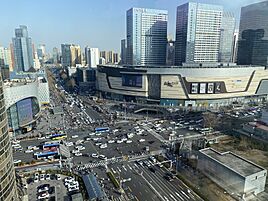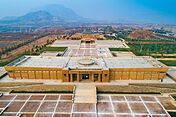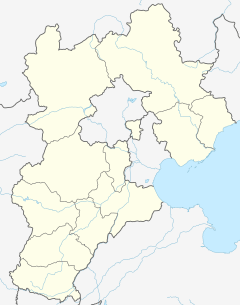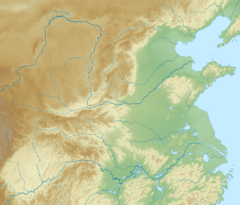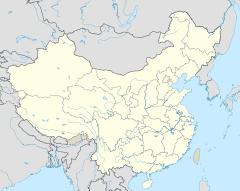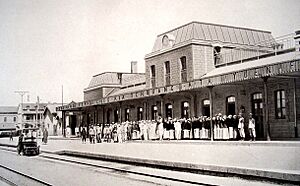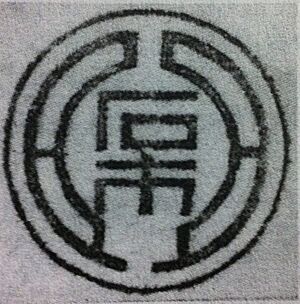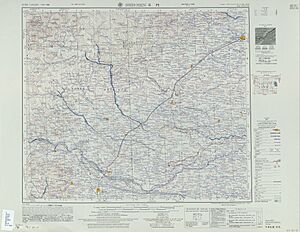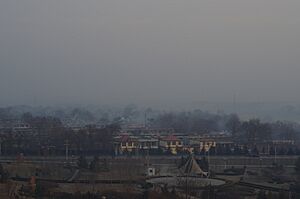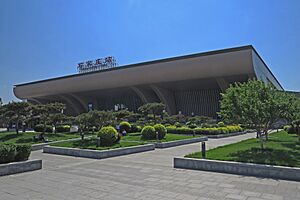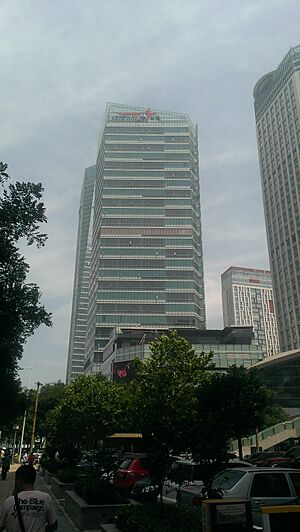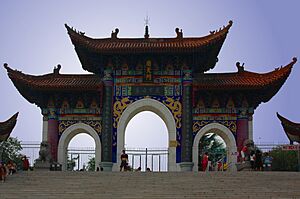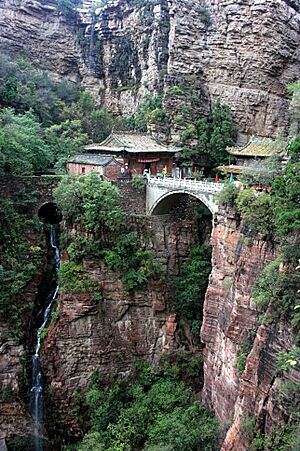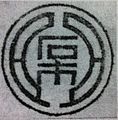Shijiazhuang facts for kids
Quick facts for kids
Shijiazhuang
石家庄市
Shihkiachwang, Shimen
|
|
|---|---|
|
Prefecture-level city
|
|
|
Skyline of Shijiazhuang from Xinbai Plaza
Shijiazhuang TV Tower
Tomb of Zhongshan state
Anji Bridge
Linji Temple
Hebei Provincial Museum
Ancient wall of Zhengding
|
|
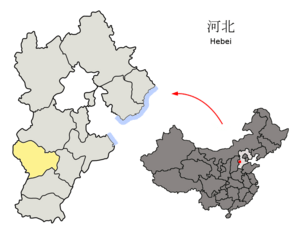
Location of Shijiazhuang City jurisdiction in Hebei
|
|
| Country | China |
| Province | Hebei |
| Settled | 204 B.C. (Changshan Commandery) |
| Established | June 24, 1925 |
| Municipal seat | Chang'an District |
| Government | |
| • Type | Prefecture-level city |
| • Body | Shijiazhuang Municipal People's Congress |
| Area | |
| • Prefecture-level city | 14,072 km2 (5,433 sq mi) |
| • Urban | 2,256.6 km2 (871.3 sq mi) |
| • Metro | 2,664.2 km2 (1,028.7 sq mi) |
| Elevation | 83 m (272 ft) |
| Population
(2020 census)
|
|
| • Prefecture-level city | 11,235,086 |
| • Density | 798.400/km2 (2,067.85/sq mi) |
| • Urban | 5,758,403 |
| • Urban density | 2,551.80/km2 (6,609.14/sq mi) |
| • Metro | 6,230,709 |
| • Metro density | 2,338.68/km2 (6,057.15/sq mi) |
| Demonym(s) | Shijiazhuangnese, Villager (colloq.) |
| GDP | |
| • Prefecture-level city | CN¥ 710 billion US$ 84.2 billion |
| • Per capita | CN¥ 52,859 US$ 7,664 |
| Time zone | UTC+8 (China Standard) |
| Postal code |
050000
|
| ISO 3166 code | CN-HE-01 |
| Licence plate prefixes | 冀A |
| City Flower | Rosa Chinensis |
| City Tree | Styphnolobium |
| GaWC World City level classification | Sufficiency |
| Rapid transit | |
| Website | www.SJZ.gov.cn |
| Shijiazhuang | |||||||||||||||||||||||||||||||
|---|---|---|---|---|---|---|---|---|---|---|---|---|---|---|---|---|---|---|---|---|---|---|---|---|---|---|---|---|---|---|---|

"Shijiazhuang" in Simplified (top) and Traditional (bottom) Chinese characters
|
|||||||||||||||||||||||||||||||
| Simplified Chinese | 石家庄 | ||||||||||||||||||||||||||||||
| Traditional Chinese | 石家莊 | ||||||||||||||||||||||||||||||
| Postal | Shihkiachwang | ||||||||||||||||||||||||||||||
| Literal meaning | "Shi Family Village" | ||||||||||||||||||||||||||||||
|
|||||||||||||||||||||||||||||||
| Shimen | |||||||||||||||||||||||||||||||
| Simplified Chinese | 石门 | ||||||||||||||||||||||||||||||
| Traditional Chinese | 石門 | ||||||||||||||||||||||||||||||
| Literal meaning | "Shi family's village and Xiumen village Portfolio" | ||||||||||||||||||||||||||||||
|
|||||||||||||||||||||||||||||||
Shijiazhuang is a big city in China. It is the capital of Hebei Province. The city is located about 266 kilometres (165 mi) southwest of Beijing.
In 2020, over 11 million people lived in Shijiazhuang. About 6.2 million of them lived in the main city area. This makes it one of the largest cities in mainland China.
Shijiazhuang grew a lot after 1949. Its population increased quickly due to new industries and buildings. The city has opened a new railway station, airport, and subway system. Shijiazhuang is located east of the Taihang Mountains. These mountains are over 400 km (250 mi) long.
Contents
- Understanding the City's Name
- A Look at Shijiazhuang's Past
- Exploring Shijiazhuang's Geography
- Shijiazhuang's Climate
- City Leaders
- City Areas and Divisions
- People and Population
- Shijiazhuang's Economy
- Getting Around Shijiazhuang
- Military Presence
- Culture and Fun in Shijiazhuang
- Sports in Shijiazhuang
- Hospitals in the City
- Education and Universities
- Sister Cities Around the World
- Images for kids
- See also
Understanding the City's Name
The name Shijiazhuang (Chinese: 石家庄) was first used during the Ming dynasty. It means "Shi family's village." The name became common after the Shijiazhuang station was built in 1907.
There are different ideas about where the name came from. One story says an emperor sent families to the area. They formed two groups: "village of 10 families" and "village of 14 families." The Chinese words for "ten" (Chinese: 十; pinyin: shí) and "stone" (Chinese: 石; pinyin: shí) sound similar. So, the name might have changed over time. Another idea is that the village was named after an important official with the last name Shi.
The city was first called "Shijia." The "zhuang" part just meant it was a village. In 1925, it was officially named Shijia. Later, it merged with another village, Xiumen. The city was then renamed Shimen (Chinese: 石门). But many people still called it "Shijiazhuang." To avoid confusion, the city's name was changed back to Shijiazhuang in 1947. People sometimes call it "international village" or "villagers."
A Look at Shijiazhuang's Past
Early Times and Dynasties
Long ago, this area was home to the Xianyu people. It later became part of the Zhongshan and Zhao states. Before the Han dynasty (before 206 BC), a city called Shiyi was here. During the Han dynasty, the area was known as Changshan. It was an important county seat until the Sui dynasty (581–618).
In the Tang dynasty (618–907), the area was reorganized. It was renamed Zhen Prefecture. The city of Zhengding was a very large city nearby. Even Marco Polo wrote about it in his travels!
The name "Shijiazhuang" first appeared in 1535. At that time, it was a small market town. It was much smaller than the nearby city of Zhengding.
Growth with Railways
Shijiazhuang started to grow into a major city in 1905. This happened when the Beijing–Wuhan railway reached the area. This railway helped trade and encouraged farmers to grow more crops. Two years later, a new railway line connected Shijiazhuang to Taiyuan. This made the town a very important transportation hub. It became a key route from Beijing and Tianjin to other parts of China.
Before World War II, Shijiazhuang was a big railway town. It was a center for trade and collecting farm products. By 1935, it was much more important than Zhengding. After World War II, the city became an important administrative and industrial center. Some industries like match making and glass making were already there.
On November 12, 1947, Communist forces took control of the city. Xibaipo, a village near Shijiazhuang, was the headquarters for the Chinese Communist Party. This was during an important time of the Chinese Civil War. Today, Xibaipo is a memorial site.
Modern Development
After the People's Republic of China was founded in 1949, Shijiazhuang grew even more. Many government groups started here. For example, the People's Bank of China was created here in 1948. It even printed the first Chinese money.
The city also became very industrial. It was chosen as one of 14 cities for major development. Its population grew more than three times between 1948 and 1958. In the 1950s, the textile industry grew a lot. Factories processed cotton and made fabrics. In the 1960s, new chemical industries started. Shijiazhuang also became a center for engineering. There are coal mines nearby that provide power for local factories.
In 1968, Shijiazhuang became the capital of Hebei province. This helped the city grow even faster. Since the 1990s, Shijiazhuang has continued to develop quickly.
Over the years, the city's areas have changed. Some county-level cities like Gaocheng and Luquan became urban districts. This means they are now more closely part of the main city.
Exploring Shijiazhuang's Geography
Shijiazhuang is in the south-central part of Hebei province. It is part of the Bohai Economic Rim. The city stretches about 148 kilometres (92 mi) from north to south and 175 kilometres (109 mi) from east to west. Its total area is about 15,722 square kilometres (6,070 sq mi). It shares borders with other cities in Hebei like Hengshui and Baoding. To the west, it borders the province of Shanxi.
The city is located at the edge of the North China Plain. To the west, the land rises into the Taihang Mountains. The Hutuo River flows south of the city. The land changes from mountains in the west to flat plains in the east.
Shijiazhuang's Climate
Shijiazhuang has a continental climate. This means it has hot, humid summers because of the East Asian monsoon. Winters are usually cold, windy, and very dry. This is due to the influence of cold air from Siberia.
Spring can bring sandstorms from the Mongolian steppe. Temperatures rise quickly, but it stays dry. Autumn is similar to spring, with mild temperatures and little rain. January is the coldest month, averaging −1.4 °C (29.5 °F). July is the warmest, averaging 27.7 °C (81.9 °F). The average temperature for the whole year is 14.3 °C (57.7 °F).
The city gets about 2,163 hours of sunshine each year. Most of the rain falls in July and August. The highest temperature ever recorded was 42.8 °C (109.0 °F). The lowest was −26.5 °C (−15.7 °F).
| Climate data for Shijiazhuang (1991–2020 normals, extremes 1951-present) | |||||||||||||
|---|---|---|---|---|---|---|---|---|---|---|---|---|---|
| Month | Jan | Feb | Mar | Apr | May | Jun | Jul | Aug | Sep | Oct | Nov | Dec | Year |
| Record high °C (°F) | 18.0 (64.4) |
25.8 (78.4) |
30.7 (87.3) |
34.9 (94.8) |
42.8 (109.0) |
42.7 (108.9) |
42.9 (109.2) |
38.6 (101.5) |
39.7 (103.5) |
34.1 (93.4) |
26.8 (80.2) |
24.5 (76.1) |
42.9 (109.2) |
| Mean daily maximum °C (°F) | 3.6 (38.5) |
7.8 (46.0) |
14.8 (58.6) |
21.9 (71.4) |
27.7 (81.9) |
32.2 (90.0) |
32.5 (90.5) |
30.7 (87.3) |
27.0 (80.6) |
20.6 (69.1) |
11.7 (53.1) |
5.1 (41.2) |
19.6 (67.4) |
| Daily mean °C (°F) | −1.4 (29.5) |
2.3 (36.1) |
9.0 (48.2) |
16.0 (60.8) |
22.1 (71.8) |
26.4 (79.5) |
27.7 (81.9) |
26.2 (79.2) |
21.6 (70.9) |
14.9 (58.8) |
6.5 (43.7) |
0.4 (32.7) |
14.3 (57.8) |
| Mean daily minimum °C (°F) | −5.2 (22.6) |
−2.0 (28.4) |
4.0 (39.2) |
10.5 (50.9) |
16.5 (61.7) |
21.1 (70.0) |
23.5 (74.3) |
22.4 (72.3) |
17.4 (63.3) |
10.4 (50.7) |
2.4 (36.3) |
−3.1 (26.4) |
9.8 (49.7) |
| Record low °C (°F) | −26.5 (−15.7) |
−19.8 (−3.6) |
−17.3 (0.9) |
−5.3 (22.5) |
3.8 (38.8) |
10.6 (51.1) |
16.2 (61.2) |
11.1 (52.0) |
3.7 (38.7) |
−2.4 (27.7) |
−14.1 (6.6) |
−18.7 (−1.7) |
−26.5 (−15.7) |
| Average precipitation mm (inches) | 3.8 (0.15) |
6.0 (0.24) |
10.3 (0.41) |
25.5 (1.00) |
37.3 (1.47) |
58.4 (2.30) |
141.4 (5.57) |
139.4 (5.49) |
59.0 (2.32) |
28.4 (1.12) |
16.8 (0.66) |
4.2 (0.17) |
530.5 (20.9) |
| Average precipitation days (≥ 0.1 mm) | 1.9 | 2.6 | 2.8 | 5.1 | 5.8 | 8.5 | 11.8 | 11.1 | 7.0 | 5.5 | 3.7 | 2.3 | 68.1 |
| Average snowy days | 3.2 | 2.7 | 1.3 | 0.2 | 0 | 0 | 0 | 0 | 0 | 0 | 1.6 | 2.6 | 11.6 |
| Average relative humidity (%) | 53 | 49 | 45 | 50 | 53 | 56 | 70 | 73 | 67 | 63 | 61 | 56 | 58 |
| Mean monthly sunshine hours | 136.1 | 152.4 | 194.8 | 222.7 | 246.7 | 209.1 | 169.6 | 180.9 | 183.5 | 176.3 | 151.9 | 138.8 | 2,162.8 |
| Percent possible sunshine | 44 | 50 | 52 | 56 | 56 | 47 | 38 | 43 | 50 | 51 | 51 | 47 | 49 |
| Source: China Meteorological Administrationall-time extreme temperature | |||||||||||||
Air Quality in Shijiazhuang
Shijiazhuang has faced challenges with air pollution. In 2013, it was listed among the most air-polluted cities globally. Many cities in northern China, including Shijiazhuang, have experienced periods of thick smog.
In 2020, the average PM2.5 air pollution in Shijiazhuang was 56 μg/m3. This is higher than the World Health Organization's guideline of 5 μg/m3. These pollution levels can affect people's health.
Sometimes, a dense wave of smog covers parts of China, including Shijiazhuang. This happens when there is not much wind. Industrial emissions and car exhaust can get trapped in the air. Officials have also pointed to coal heating systems as a cause.
City Leaders
| Departments |
Secretary of the Shijiazhuang Municipal Committee of the Chinese Communist Party |
Director of the Standing Committee of the Shijiazhuang People's Congress |
Mayor of Shijiazhuang People's Government |
Chairman of Shijiazhuang Municipal Committee of the Chinese People's Political Consultative Conference |
|---|---|---|---|---|
| Name | Zhang Chaochao | Li Xuerong | Ma Yujun | Zhang Ye |
| Ethnic Group | Han | Han | Manchu | Han |
| Native place | Shangcai County, Henan | Zhangjiakou,Hebei | Luanping County,Hebei | Xinji,Hebei |
| Birth date | December 1967 (age 58) | June 1963 (age 62) | June 1965 (age 60) | August 1963 (age 62) |
| Date of assumption of duty |
April 2021 | February 2021 | January 2021 | February 2021 |
City Areas and Divisions
Shijiazhuang is divided into different administrative areas. These include city districts, county-level cities, and counties.
| Map | |||||
|---|---|---|---|---|---|
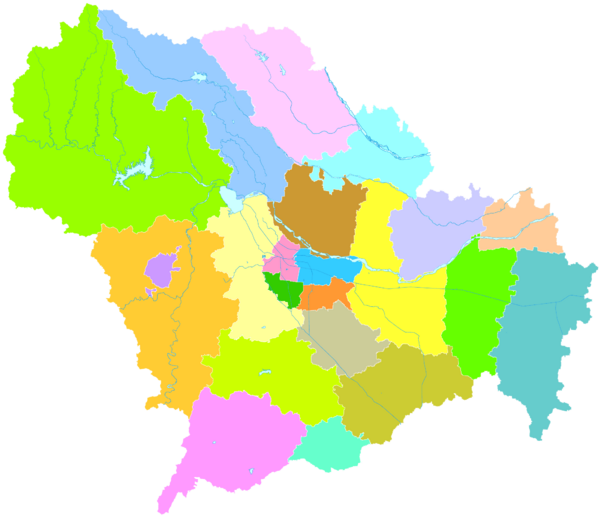
Chang'an
Qiaoxi
Xinhua
Yuhua
Luancheng
Gaocheng
Luquan
Jingxing
Jingxing
County Xingtang
County Lingshou
County Gaoyi
County Shenze
County Zanhuang
County Wuji
County Pingshan
County Yuanshi
County Zhao
County Xinji
(city) Jinzhou
(city) Xinle
(city) |
|||||
| Name | Chinese | Pinyin | Population (2010) | Area (km2) | Density (/km2) |
| City proper | |||||
| Chang'an District | 长安区 | Cháng'ān Qū | 560,643 | 110 | 4,362 |
| Qiaoxi District | 桥西区 | Qiáoxī Qū | 596,164 | 53 | 11,248 |
| Xinhua District | 新华区 | Xīnhuá Qū | 625,119 | 92 | 6,795 |
| Yuhua District | 裕华区 | Yùhuá Qū | 574,572 | 101 | 4,888 |
| Luancheng District | 栾城区 | Luánchéng Qū | 328,933 | 347 | 948 |
| Gaocheng District | 藁城区 | Gàochéng Qū | 775,110 | 836 | 927 |
| Luquan District | 鹿泉区 | Lùquán Qū | 432,936 | 603 | 718 |
| Suburban | |||||
| Jingxing Mining District | 井陉矿区 | Jǐngxíng Kuàngqū | 95,170 | 56 | 1,699 |
| Zhengding County | 正定县 | Zhèngdìng Xiàn | 466,807 | 568 | 822 |
| Satellite cities | |||||
| Xinji City | 辛集市 | Xīnjí Shì | 615,919 | 951 | 648 |
| Jinzhou City | 晋州市 | Jìnzhōu Shì | 537,679 | 619 | 868 |
| Xinle City | 新乐市 | Xīnlè Shì | 487,652 | 625 | 780 |
| Rural | |||||
| Jingxing County | 井陉县 | Jǐngxíng Xiàn | 309,882 | 1,381 | 224 |
| Xingtang County | 行唐县 | Xíngtáng Xiàn | 406,353 | 1,025 | 396 |
| Lingshou County | 灵寿县 | Língshòu Xiàn | 333,558 | 1,546 | 216 |
| Gaoyi County | 高邑县 | Gāoyì Xiàn | 186,478 | 222 | 840 |
| Shenze County | 深泽县 | Shēnzé Xiàn | 250,264 | 296 | 845 |
| Zanhuang County | 赞皇县 | Zànhuáng Xiàn | 244,799 | 1,210 | 202 |
| Wuji County | 无极县 | Wújí Xiàn | 502,662 | 524 | 959 |
| Pingshan County | 平山县 | Píngshān Xiàn | 433,429 | 2,951 | 147 |
| Yuanshi County | 元氏县 | Yuánshì Xiàn | 418,466 | 849 | 493 |
| Zhao County | 赵县 | Zhào Xiàn | 571,077 | 714 | 800 |
People and Population
Many people have moved to Shijiazhuang over the years. This has helped its population grow a lot. In 1947, the city had 120,000 people. By 1949, it had more than doubled to 270,000.
By 1960, the city's population reached 650,000. In 1968, it grew even more when it became the capital of Hebei. By 1980, over one million people lived in the city. By the end of 2017, the urban population was over 4.5 million.
In just 60 years, the city's population has grown more than 20 times! In 2009, the non-migrant population was about 9.7 million. The birth rate was 14.65%, and the death rate was 6.25%.
The 2010 census showed a total population of over 10 million. This was an increase of 8.76% from ten years before. There were slightly more males than females. About 15% of the population was aged 0-14. About 76% were aged 15-64.
The most common last names in Shijiazhuang are Zhang, Wang, and Li. In 2011, a survey found that people in Shijiazhuang were very happy.
Shijiazhuang's Economy
In 2014, Shijiazhuang's economy was worth about CN¥510.02 billion (around $80.45 billion USD). This showed a 12% increase from the year before. The city is a major industrial hub in North China. It is seen as an economic center for Hebei province.
Shijiazhuang is known as the "medicine hub of China." It has big pharmaceutical companies and factories. The textile industry is also very important to the city's business. Other industries include machinery, chemicals, building materials, and electronics.
The city has lots of farms. It has 590,000 hectares of farmland. It is a main source of cotton, pears, dates, and walnuts in Hebei. In 2008, the city's imports reached US$1.393 billion. Exports grew to US$5.596 billion.
Special Development Zones
- Shijiazhuang High-Tech Industrial Development Zone
This zone was created in 1991. It is a special area for new high-tech businesses. Major highways pass through the zone. It is close to the railway station and Tianjin Port. Industries here include medicine, electronics, machinery, and chemicals.
The Eastern District of the zone focuses on new high-tech companies. The Western District helps smaller tech businesses. The Liangcun District focuses on the pharmaceutical and petrochemical industries. By 2009, about 2,600 businesses had set up in the zone. Many of these were foreign companies.
Getting Around Shijiazhuang
Highways and Railways
Shijiazhuang has many expressways. These include the Shitai, Beijing–Shenzhen, and Taiyuan–Cangzhou Expressways.
The city is a major railway hub. It is where the Beijing–Guangzhou, Taiyuan–Dezhou, and Shuozhou–Huanghua railways meet. The new Shijiazhuang railway station opened in 2012. It is special because both regular and high-speed trains use it. A 5 km (3.1 mi) long tunnel was built under the city for the high-speed railway. This was the first time a high-speed train ran under a Chinese city. There is also a smaller station, Shijiazhuang North railway station, for trains going west.
Metro System
Shijiazhuang has a subway system called the Shijiazhuang Metro. Lines 1, 2, and 3 are currently running. The system is 76.5 km (47.5 mi) long. Plans include a total of 6 metro lines.
Airport and Cycling
The Shijiazhuang Zhengding International Airport is the main airport for the province. It is about 30 kilometers northeast of the city. The airport has flights to many cities in China and 12 international destinations. It is being expanded to help with flights to and from Beijing. The airport also has its own train station.
Shijiazhuang is great for cycling. Most large roads have special bike lanes. The city is flat, which makes cycling easy. Thousands of people ride bikes here every day.
Military Presence
Shijiazhuang is home to the headquarters of the 27th Group Army. This is part of the People's Liberation Army. This group helps protect China's capital, Beijing.
Culture and Fun in Shijiazhuang
City Center Attractions
Shijiazhuang's roads mostly run north-south and east-west. This makes the city easy to get around. Many roads have bike paths, making it bike-friendly. In the city center, you'll find the Hebei Museum. It was updated in 2013 and 2014. The museum often shows traditional Chinese art.
The Yutong International Sports Centre hosts football matches for the Shijiazhuang Ever Bright team. It also holds pop concerts.
The Shijiazhuang Zoo is on the west side of the city. It has 3,000 animals from 250 different types. You can see flamingos, golden monkeys, and pandas. Near the zoo are the Botanical Gardens (Chinese: 石家庄植物园). They have many different kinds of plants. The Martyrs Memorial (Chinese: 烈士纪念馆) is in the city center. It honors soldiers who died in wars.
Main Sights to See
Baodu Zhai (Chinese: 抱犊寨; pinyin: Bàodúzhài) is an old hilltop fort on the west side of the city. It has walking paths and Buddhist statues. Close by is Fenglong Mountain (Chinese: 封龙山). This mountain offers walks and a large stone Buddha statue. Mount Cangyan (Chinese: 苍岩山; pinyin: Cāngyán Shān; literally "Green Cliff Mountain") is a beautiful area in Jingxing County. It is known for its mix of nature and old buildings. A scene from the movie Crouching Tiger, Hidden Dragon was filmed here.
The Longxing Temple (Chinese: 隆興寺; pinyin: Lóngxīng Sì) is an ancient Buddhist temple just outside the city. It is called the "First Temple south of Beijing." The Anji Bridge (also known as Zhaozhou Bridge) (Chinese: 安濟橋; pinyin: Ānjì Qiáo; literally "Safe crossing bridge") is the oldest open-spandrel stone arch bridge in the world. It was built between 595 and 605 AD. It is the oldest standing bridge in China. The Pagoda of Bailin Temple (Chinese: 從諗禪師舍利塔; pinyin: Cóngshěn Chánshī Shělìtǎ or Chinese: 趙州塔; pinyin: Zhàozhōu Tǎ) is a brick pagoda built in 1330.
City Parks for Fun
Shijiazhuang has many parks in its downtown area. The biggest is Chang'an Park (Chinese: 长安公园). It has an underground shopping mall, a theater, a museum, a lake, and restaurants. Century Park (Chinese: 世纪公园) is on the southeast side. It has a lake and an amusement park. Water Park (Chinese: 水上公园) is on the northwest side. It features a large lake, rides, and restaurants. There are also many smaller parks around the city.
Shopping and Food
The largest mall in the city is the Wanda shopping mall. It is in the southeast and has an IMAX theater. Other big malls include the Lerthai Shopping Complex downtown and Wondermall.
In summer, many barbecue restaurants (Chinese: 烧烤) open. They sell different foods, with lamb kebabs (Chinese: 羊肉串) being very popular. You can find thousands of restaurants in the city. They offer Chinese and Western food, often open all day and night.
Famous People from Shijiazhuang
- Li Deyu: A Chinese poet and politician from the Tang dynasty.
- Zhou Dongyu: An actress, one of the famous "Four Dan actresses" of her generation.
- Kang Hui: A news anchor for China Central Television.
- Deng Lun: A popular actor.
- Omnipotent Youth Society: A Chinese alternative rock band.
- Han Xu: A WNBA basketball player for the New York Liberty.
- Sun Yingsha: A talented table tennis player.
- Zheng Yuanjie: A Chinese fairy tale author.
- Zhao Yun: A military general from ancient China.
- Feng Zhang: A Chinese-American biochemist known for CRISPR technology.
Sports in Shijiazhuang
Shijiazhuang Gongfu F.C. (Chinese: 石家庄功夫; pinyin: Shíjiāzhuāng Gōngfu) is a football club from Shijiazhuang. They play in the China League One. Their home stadium is the Yutong International Sports Centre, which holds 37,000 people.
The Yutong International Sports Center (Chinese: 裕彤国际体育中心) is a large stadium. It is mostly used for football games and can hold 38,500 people. Fumei Shijiazhuang FC is a futsal club from the city. They play in the Futsal Premier League.
Hospitals in the City
- Hebei General Hospital
- The First Hospital of Shijiazhuang City
- The Third Hospital of Hebei Medical University
- Bethune International Peace Hospital Chinese: 白求恩国际和平医院; pinyin: Báiqiú'ēn'Hépíng'Yīyuàn: Named after Norman Bethune, a Canadian doctor. He is remembered for bringing modern medicine to rural China.
Education and Universities
Universities and Colleges
Shijiazhuang has several universities and colleges:
- Shijiazhuang University
- Hebei GEO University
- Shijiazhuang Tiedao University
- Hebei Normal University
- Hebei Medical University
Sister Cities Around the World
Shijiazhuang has many sister cities in different countries:
 Nagano, Japan (since 1981)
Nagano, Japan (since 1981) Saskatoon, Canada (since 1985)
Saskatoon, Canada (since 1985) Des Moines, Iowa, United States (since 1986)
Des Moines, Iowa, United States (since 1986) Edison, New Jersey, United States
Edison, New Jersey, United States Parma, Italy (since 1987)
Parma, Italy (since 1987) Corby, England, United Kingdom (since 1994)
Corby, England, United Kingdom (since 1994) Ayagawa, Japan (since 1995)
Ayagawa, Japan (since 1995) Solofra, Italy (since 1997)
Solofra, Italy (since 1997) Cheonan, South Korea (since 1997)
Cheonan, South Korea (since 1997) Querétaro City, Mexico (since 1997)
Querétaro City, Mexico (since 1997) Richmond Hill, Canada (since 1998)
Richmond Hill, Canada (since 1998) Falkenberg, Sweden (since 2002)
Falkenberg, Sweden (since 2002) Nam Định, Vietnam (since 2004)
Nam Định, Vietnam (since 2004) Nagykanizsa, Hungary (since 2007)
Nagykanizsa, Hungary (since 2007)
Images for kids
See also
 In Spanish: Shijiazhuang para niños
In Spanish: Shijiazhuang para niños


